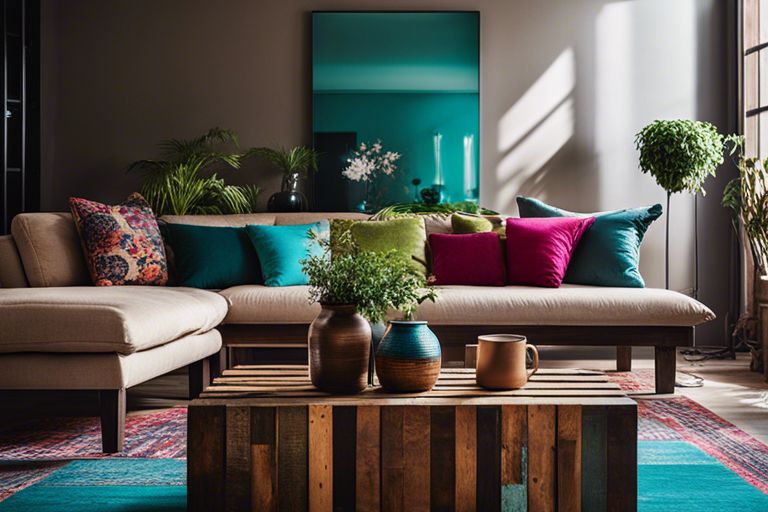Enrich your urban Indian lifestyle with eco-chic living as we delve into the art of reusing, recycling, and upscaling in your home. Learn how to incorporate sustainable and stylish practices into your daily life, from repurposing furniture to rethinking your approach to home décor. Embrace the positive impact your choices can have on the environment while creating a stunning interior for your home. Discover more tips and techniques in the book Eco Chic Home: Rethink, Reuse, and Remake Your Way to … and embark on a journey to transform your living space into a sustainable sanctuary.
Table of Contents
Key Takeaways:
- Sustainable Lifestyle: Eco-chic living promotes a sustainable lifestyle through reusing, recycling, and upcycling in urban Indian homes. It encourages conscious consumption and responsible waste management.
- Creative Reuse: Embracing eco-chic living allows individuals to creatively repurpose items, turning waste into valuable resources. It fosters a culture of creativity and innovation to make the most of limited resources.
- Environmental Impact: By incorporating eco-friendly practices into daily living, urban Indian homes can significantly reduce their environmental impact, contributing to a greener and healthier planet for future generations.
Types of Recyclable and Reusable Materials
Some of the recyclable and reusable materials commonly found in urban Indian homes include:
- Paper
- Plastic
- Glass
- Metal
- Textiles
Recognizing the potential for these materials to be reused or recycled is essential for eco-conscious living.
Common Urban Household Items for Reuse
Household items such as glass jars, plastic containers, and old clothing can easily be repurposed for various uses around the home. By finding creative ways to reuse these items, you can reduce waste and minimize your environmental impact.
Classifying Recyclable Materials by Category
On the other hand, recyclable materials can be classified into categories such as paper, plastic, glass, metal, and textiles. By sorting and separating these materials, you can ensure that they are properly recycled and diverted from landfills.
For instance, recyclable paper can include newspapers, magazines, and cardboard, while recyclable plastic can encompass bottles, containers, and packaging materials.
Tips for Implementing Eco-Chic Practices
Even in the bustling urban environment of Indian homes, it is possible to embrace eco-chic living by implementing a few simple practices. By following these tips, you can reduce your carbon footprint and contribute to a more sustainable planet. As a responsible citizen, it is important to prioritize reusing, recycling, and upscaling in your daily life. Knowing the impact of your actions, you can make a difference in the world.
Reducing Household Waste
Tips for reducing household waste include composting organic materials, using reusable containers instead of disposable ones, and donating unwanted items instead of discarding them. By following these practices, you can significantly minimize the amount of waste that ends up in landfills and contribute to a healthier environment.
Shopping with Sustainability in Mind
Practices for shopping with sustainability in mind involve choosing products with minimal packaging, supporting local artisans and businesses, and opting for eco-friendly materials whenever possible. By making conscious choices while shopping, you can support a more sustainable and ethical consumer culture. With Eco Chic Upcycling Arts, you can discover unique upcycled products that align with eco-chic principles.
With a growing awareness of environmental issues, it is essential to incorporate sustainable practices into our shopping habits to promote a more ethical and eco-friendly lifestyle.
Creative Reuse and Decoration Ideas
Waste can be turned into treasure with creative reuse and decoration ideas. Repurposing old furniture, upcycling clothing and accessories, and creating DIY decor from recycled materials are just a few examples of how you can elevate your living space while reducing waste and contributing to a more sustainable lifestyle.
A little creativity goes a long way in transforming waste into something beautiful and functional for your home, enhancing your living space while also minimizing environmental impact.
Step-by-Step Guide to Upcycling at Home
Keep your home eco-friendly and stylish with upcycling, a creative way to repurpose items and reduce waste. Here’s a step-by-step guide to help you get started!
| Identifying Potential for Upcycled Items | Planning and Executing Upcycling Projects |
|
For successful upcycling, start by identifying items in your home that have the potential for a second life. Look for items that are sturdy, well-crafted, and could be transformed with a little creativity. |
Identifying the potential of an item is just the beginning. Next, plan the execution of your upcycling project. Research different ways to repurpose the item and gather the necessary tools and materials. |
Identifying Potential for Upcycled Items
For successful upcycling, start by identifying items in your home that have the potential for a second life. Look for items that are sturdy, well-crafted, and could be transformed with a little creativity. Old wooden furniture, glass jars, and fabric scraps are all great candidates for upcycling. Take a closer look at the condition of the item and envision how it could be repurposed. With some imagination and resourcefulness, you can breathe new life into these items and reduce your environmental impact at the same time.
Planning and Executing Upcycling Projects
Identifying the potential of an item is just the beginning. Next, plan the execution of your upcycling project. Research different ways to repurpose the item and gather the necessary tools and materials. Once you have a clear vision for the project, gather the necessary supplies and set aside dedicated time to work on it. Take your time and enjoy the creative process of upcycling. It may take patience and effort, but the end result will be a unique, environmentally-friendly addition to your home.
For instance, you could transform an old wooden chair into a stylish plant stand, or repurpose fabric scraps into a colorful quilt. The possibilities are endless, and each upcycling project brings a sense of accomplishment and pride in reducing waste and embracing sustainable living.
Factors to Consider for Eco-Chic Living
Not all homes are designed to embrace ecofriendly practices. Urban Indian homes often face challenges when it comes to incorporating reuse, recycle, and upscale practices. When considering eco-chic living in an urban setting, there are several factors to take into account.
- Space limitations
- Local resources
- Budget constraints
- Community support
Any ecofriendly lifestyle must be practical and sustainable within the confines of an urban home. This requires a careful consideration of the unique challenges and opportunities.
Space Limitations in Urban Homes
Living in an urban environment often means dealing with limited living spaces. Finding creative ways to incorporate ecofriendly practices into a small apartment or house can be challenging. However, with careful planning and strategic use of space, it is possible to live sustainability even in a limited area.
Balancing Aesthetics with Sustainability
EcoChic living is not just about being ecofriendly, it’s also about creating a visually appealing living space. Balancing aesthetics with sustainability can be a delicate task, but it is achievable. By choosing sustainable materials, incorporating natural elements, and being mindful of design choices, it is possible to create a space that is both beautiful and ecofriendly.
For instance, choosing upcycled furniture pieces can not only add a unique charm to your home but also reduce the demand for new resources, contributing to a more sustainable lifestyle.
Pros and Cons of Eco-Chic Lifestyle
Despite the numerous benefits of adopting an eco-chic lifestyle, there are also some drawbacks to consider. It’s important to weigh the pros and cons before making the commitment to a more sustainable way of living.
| Pros | Cons |
| Environmental impact | Initial cost |
| Cost savings | Time commitment |
| Health benefits | Limited choices |
| Community and social impact | Education and learning curve |
| Long-term sustainability | Resistance from family and friends |
| Opportunities for creativity | Convenience |
| Individual empowerment | Availability of resources |
Environmental Impact and Cost Savings
Savings in energy, water, and resources like paper and plastic are some of the immediate benefits of adopting an eco-chic lifestyle. Additionally, by repurposing and reusing items, there are significant cost savings to be realized. This can contribute to a more sustainable and budget-friendly way of living for urban Indian homes. For more information on household maintenance, check out R5 Zen and The Art of Household Maintenence.
Challenges and Commitment Required
The commitment to an eco-chic lifestyle may present challenges such as the initial investment in eco-friendly products and the time required to research and implement changes in daily habits. Additionally, limited availability of sustainable options and the need for education and support can make the transition challenging. However, the long-term benefits outweigh these challenges, and with dedication, the commitment to sustainability becomes easier over time.
A dedicated effort to overcome these challenges and commit to an eco-chic lifestyle is essential for creating a positive impact on the environment and maintaining a healthy, sustainable home. It requires a willingness to embrace change, educate oneself, and collaborate with others in the community to achieve a greener way of life.
Eco-Chic Living – How to Reuse, Recycle, and Upscale in Urban Indian Homes
Taking this into account, it is clear that adopting eco-friendly practices in urban Indian homes is not only crucial for preserving the environment but also for creating stylish and sustainable living spaces. With a focus on reusing, recycling, and upscaling, individuals can reduce their environmental impact while also saving money and adding unique, personalized touches to their homes. By incorporating these principles into their lifestyles, urban Indian homeowners can play a significant role in promoting a more eco-conscious and environmentally friendly way of living. It is our responsibility to take action and make a positive difference in our communities, and embracing eco-chic living is a practical and effective way to do so.
FAQ
Q: What is Eco-Chic Living?
A: Eco-Chic Living is a lifestyle that focuses on embracing sustainability, reusing, recycling, and upcycling items to create a stylish and eco-friendly home environment. It promotes a conscious and mindful approach to consumption and waste reduction.
Q: How can I incorporate Eco-Chic Living in my urban Indian home?
A: You can incorporate Eco-Chic Living in your urban Indian home by adopting simple practices such as using eco-friendly materials for furnishings, upcycling old furniture and decor, reducing energy consumption, and incorporating greenery and plants into your living space. It’s about making conscious choices to minimize your environmental impact while creating a chic and stylish home.
Q: What are some practical tips for reusing, recycling, and upcycling in urban Indian homes?
A: Practical tips for reusing, recycling, and upcycling in urban Indian homes include repurposing old sarees and fabrics into cushion covers or quilts, using glass jars and containers for storage instead of plastic, upcycling wooden pallets into furniture, and composting kitchen waste to create nutrient-rich soil for gardening. It’s about finding creative ways to give new life to old items and reduce waste in your home.






